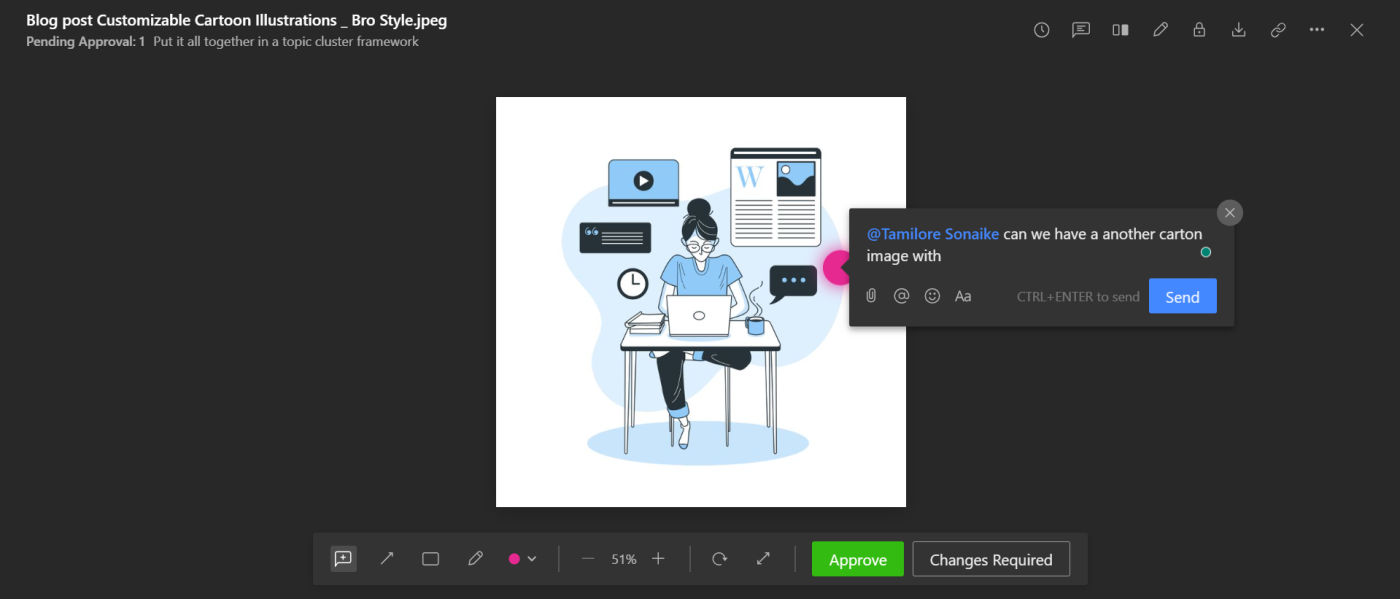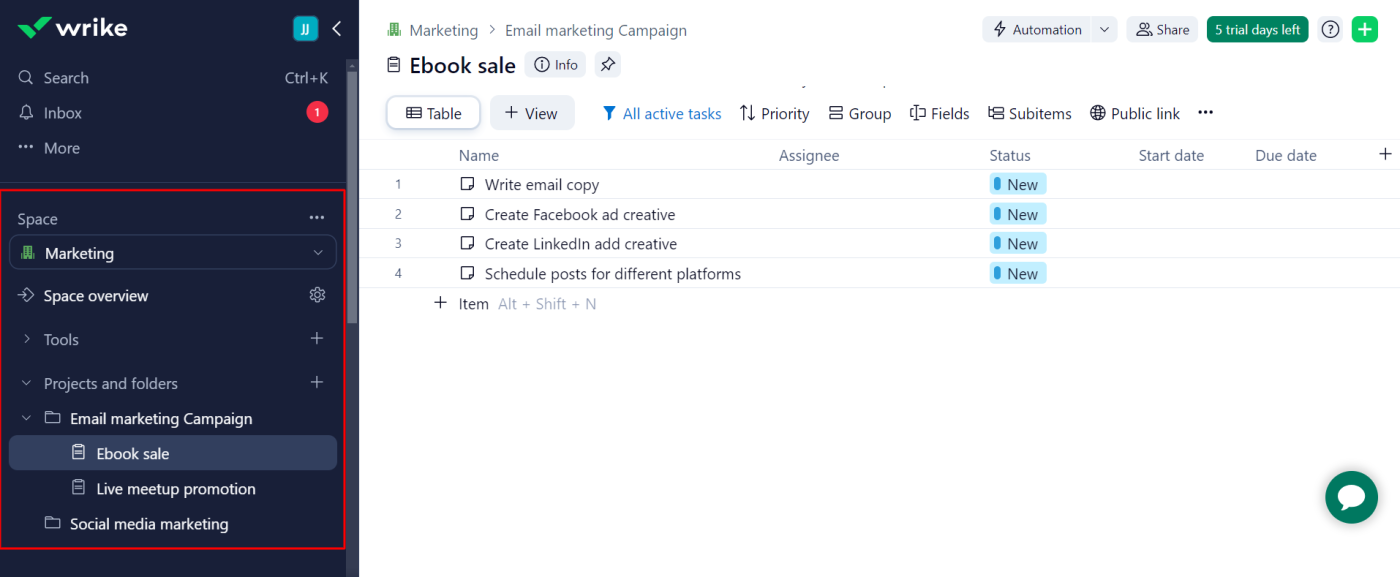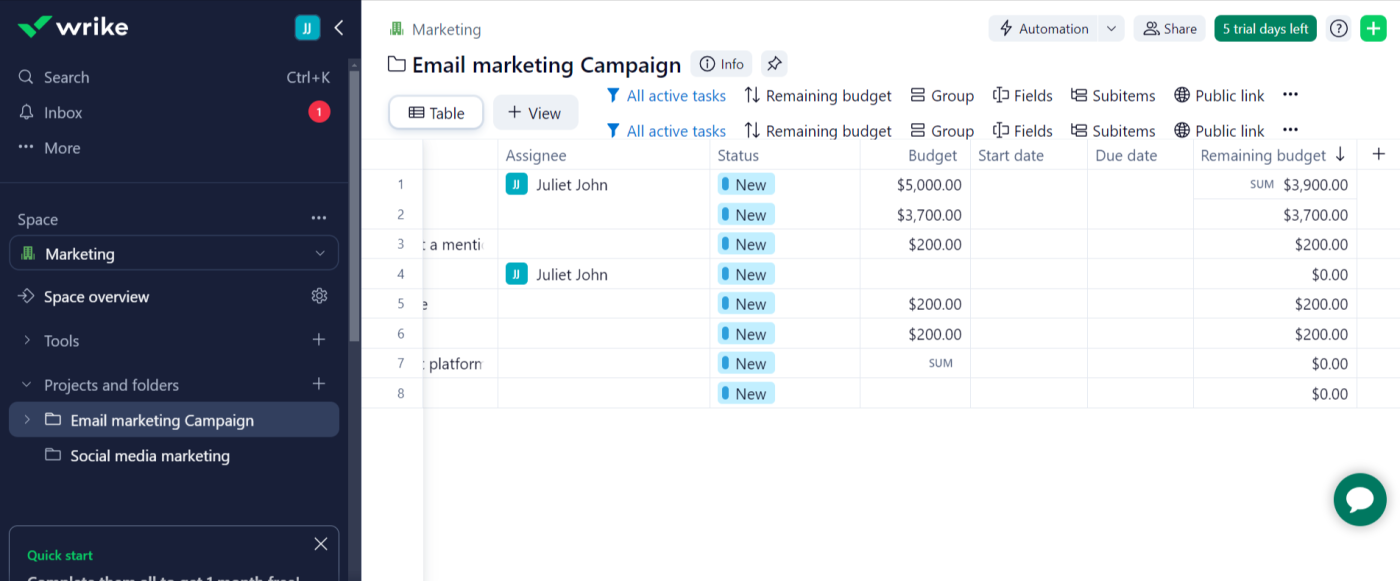If you’re in the market for a new project management app, you’ve likely come across Wrike and Asana. They each pack a powerful set of features to help teams of all sizes organize their work more efficiently. But while they have a lot of similarities—and appeal to similar audiences—they do offer different experiences.
I’ve used Asana and Wrike quite a bit over the years, and for this article, I dove back into both of them, testing each app in depth to help you figure out the best project management tool for your team. Here’s my take on how they stack up.
Table of contents:
Wrike vs. Asana at a glance
Here’s a quick summary of the main differences between Wrike and Asana, but keep reading for more details on each app’s strengths and weaknesses and my experiences testing them.
-
Asana is best for small-to-medium businesses. With its generous free plan, easy-to-use interface, and collaboration tools, it provides an easy way for teams to manage tasks and enhance productivity.
-
Wrike is better for larger teams and more complex projects. It offers a more structured way of organizing projects, includes budgeting capabilities, and has more customization options.
|
Asana |
Wrike |
|
|---|---|---|
|
Ease of use |
⭐⭐⭐⭐⭐ Minimalist and clean interface that’s easy to navigate |
⭐⭐⭐⭐ Slightly cluttered interface that can be confusing at first |
|
Collaboration |
⭐⭐⭐⭐⭐ Comes with a dedicated inbox for chatting; offers task comments and mentions |
⭐⭐⭐⭐ No inbox; offers task comments and mentions |
|
Customization |
⭐⭐⭐⭐ Offers customizable views—but not as many as Wrike |
⭐⭐⭐⭐⭐ Lots of customizable views for task management |
|
Pricing |
⭐⭐⭐⭐⭐ Generous free plan and allows you to pay monthly |
⭐⭐⭐⭐ Also great free plan but only offers annual billing |
|
Integrations |
⭐⭐⭐⭐⭐ Integrates with 100+ third-party tools, including Zapier |
⭐⭐⭐⭐⭐ Integrates with 400+ third-party tools, including Zapier |
|
AI features |
⭐⭐⭐⭐⭐ Useful AI features to support all parts of your project management, from generating projects to creating workflows and reports |
⭐⭐⭐⭐ You can use AI to generate content, create summaries, and automation rules |
|
Ideal user |
Small-to-medium businesses looking for an easy way to manage tasks and projects |
Larger businesses managing projects across several teams |
Both tools are easy to use, but Asana offers a smoother experience
If you’re looking for a project management tool that’s easy to set up and use immediately, you can’t go wrong with either option. When you create an account with either tool, it’ll guide you in setting up your first project with tasks, teammates, and the layout that works best for you.
But once you’re set up and inside the dashboard, you’ll immediately notice that Asana delivers a smoother user experience. When I log in to Asana, I see a clean dashboard that gives me a quick summary of all my projects, tasks, and collaborators. Then there’s a left navigation pane with tools and features neatly organized and labeled. (Asana even lets you sync your dashboard with your system’s settings for a more custom look and provides accessibility options.)

Wrike, on the other hand, feels more cluttered. Whenever I log in, it opens up a project with a bunch of features, including settings and groups. There’s a left navigation pane with spaces, tools, and projects in a collapsible folder system. You’ll eventually figure out what each item means, but the interface will continue to feel more cramped and less easy than Asana.

And while both apps offer plenty of different views, Asana makes it easier to access them by providing multiple views by default for you to choose from.

With Wrike, you only get a table view by default, and you’ll need to enable other views to see your project differently. It’s not the end of the world, but it’s a good indication of how much more streamlined Asana is.
Asana has more robust collaboration features
Asana and Wrike are both built for collaboration, so they offer all the basics. In both tools, you can add dependencies, share files, and use portfolio/workload tracking to manage work efforts. But beyond that, Asana provides more ways to streamline communication and improve collaboration.
For example, both tools offer proofing, a feature that lets you add visual feedback to creative assets. But Asana takes it one step further and automatically turns your feedback into subtasks, assigning it to the person who uploaded the asset. You can attach a due date to the subtask, and teammates can comment on it and ask clarifying questions as they work through the edits. Making it a subtask helps keep all the feedback in one place, so team leads or stakeholders can efficiently track updates and get the context they need to give approvals.

In contrast, Wrike only lets you tag teammates to comments when proofing images or files.

Asana also lets you manage team communications in a dedicated inbox. Each project has a Messages tab where you can converse with the entire team or a select few. This feature is super helpful for holding focused or even casual, non-work-related discussions without cluttering individual task comments.

With Wrike, there’s no way to centralize your conversations in one place—you can only comment on tasks.
Asana even provides dedicated team pages for improving collaboration across organizational departments. For example, you can group people by function or department—like marketing, sales, or product—and each team can have its own set of projects, goals, and calendars to keep work organized. Teams can communicate, manage resources, and monitor progress from a centralized place without dealing with unrelated projects.

Wrike offers user groups but without the granularity of Asana’s Teams. There are no goals, team calendars, or dedicated inboxes. You also can’t tag individual teammates to conversations without notifying the entire group. Wrike’s user groups provide a way to communicate with everyone in a particular company function simultaneously, but they don’t offer the collaborative features that make Asana’s teams feature more powerful.
Wrike is more customizable and has more tools for big teams and advanced project management
Asana and Wrike both offer all the important basics you need from a project management app:
-
Tables/lists, Kanban boards, Gantt charts, and calendars for creating and visualizing tasks
-
The ability to add files to projects and tasks
-
Time tracking
-
Task dependencies
-
The ability to create workflows and use automation rules to streamline them.
But if you’re planning a complex project or managing lots of teams, Wrike is a bit more up for the task.
Let’s start with its project organization system. Most project management tools (including Asana) allow you to create projects and then break them down into lists of tasks and subtasks. That’s a straightforward way of organizing simple projects.
Wrike, with its spaces and project folders, brings a unique way of organizing work into hierarchies. Wrike’s system is really customizable and perfect for users who prefer to organize work in different ways—e.g., by client, team, or function. You can set up spaces for various company departments or teams (e.g., Marketing) and then categorize your work in those teams into folders (e.g., social media marketing campaigns, email marketing campaigns). Folders can contain different kinds of individual projects your team will work on. Then, you can break these projects into tasks and subtasks for teammates to handle.

This level of organization might be too much for a small team just looking for a simple task list. But it’s beneficial for larger organizations with an unruly amount of projects and data to track. You’ll also get precise control over who can access these spaces, folders, and projects to ensure the safety of your data.
As you create projects, Wrike lets you estimate and track financials by assigning budgets to individual tasks (via custom fields) if you’re on the Business plan. Wrike can even calculate those budgets automatically when you enable formulas. These features make financial management easy without the need for a third-party tool.

On higher-tier plans, like the Enterprise Pinnacle, you’ll get a complete set of financial features with predefined fields that automatically calculate your project’s essential financial metrics. Asana, on the other hand, has a formula custom field but doesn’t have any true budgeting features.
Wrike also gives you more customization options than Asana. You’ll get multiple customizable calendars that you can assign to specific teams and projects; and in addition to the standard project views (list, boards, calendar, Gantt/timeline), it offers others: resources, time log, analytics, stream, and chart. You can customize each of these views to specific objectives or preferred work styles.

Asana’s AI is more useful
AI is becoming a standard feature in project management tools, and both Wrike and Asana are incorporating it in useful ways. Wrike offers AI assistance for generating and refining content and creating automation rules. When creating tasks and subtasks in Wrike, you can use AI to generate descriptions by instructing it on what to write or choosing from the available prompts.

As you add comments to tasks, the AI can fix typos, shorten, summarize, or translate the comment into a different language. Wrike AI can also help you get up to speed with important conversations within tasks by summarizing the entire discussion and highlighting action items.

Asana, on the other hand, offers more widespread AI capabilities throughout the platform. Whether you’re writing comments, creating tasks, reviewing recent activity, or automating workflows, Asana AI productivity features are designed to support and improve your workflow.
For example, you can set up new custom projects faster using Asana’s Smart Projects. Once you provide a project name and description, Asana AI will build out a solid structure organized by sections and fields.

As you work through projects, the AI can help you generate status reports to maintain alignment and provide updates for stakeholders. It’ll analyze your real-time data within a specific timeline to generate updates highlighting key insights, roadblocks, or potential risks.

For a web design project I’m managing on Asana, the AI summarized the entire project, surfaced potential blockers, and suggested action steps to move things forward. This really cuts the time you’d otherwise spend compiling reports.

You can also use Asana AI to automatically generate workflows for managing your project. When setting workflow rules, the AI can make tailored suggestions for your specific project context or use your description to create an automated workflow.

If you’re on higher-tier plans like the Advanced plan, you can use Asana AI studio to embed AI agents directly in your workflow, automate triaging requests, and generate full-on content like blog posts.
Pricing is comparable, with a few quirks
Wrike and Asana both offer solid free plans, but Asana’s is a bit more generous: it includes access to a calendar view and basic reporting, which Wrike locks behind its paid tiers.
After the free introductions, Wrike starts at $10/user/month. It’s a hair cheaper than Asana ($10.99/user/month), but Wrike’s plans are only billed annually, so if you just need a tool for a short time, it’s not ideal. Wrike’s plans are also capped based on the number of users—for example, you can only have up to 15 users on the cheapest plan. That makes it less attractive for businesses that need its advanced features but have more team members. Meanwhile, Asana allows you to have unlimited users on any plan.
Both apps integrate with third-party tools, including Zapier
With 400+ integrations, Wrike integrates natively with more apps—especially marketing and financial tools—so you can have a single source of truth for your entire business.
But both Wrike and Asana support Zapier, so you can connect them to thousands of other apps. Learn more about how to streamline your Asana workflows and automate your Wrike workflows, or get started with one of these templates.
Zapier is a no-code automation tool that lets you connect your apps into automated workflows, so that every person and every business can move forward at growth speed. Learn more about how it works.
Asana vs. Wrike: Which is best for your team?
In terms of core features, Asana and Wrike are pretty alike, so deciding on the best one for your team honestly might come down to testing them to see which one feels the best. Since both offer generous free plans and solid trials, you can poke around in both. As you do, here are some guidelines to keep in mind:
-
Asana will serve you well if you have a smaller team or are looking for a simple tool with no learning curve.
-
Wrike is better if customizations are essential to your workflow and you want more than basic task lists and boards.
Related reading:
This article was originally published in May 2024. The most recent update was in June 2025.